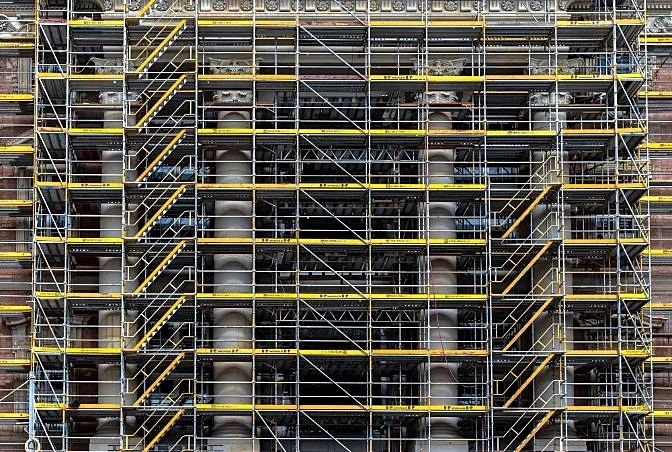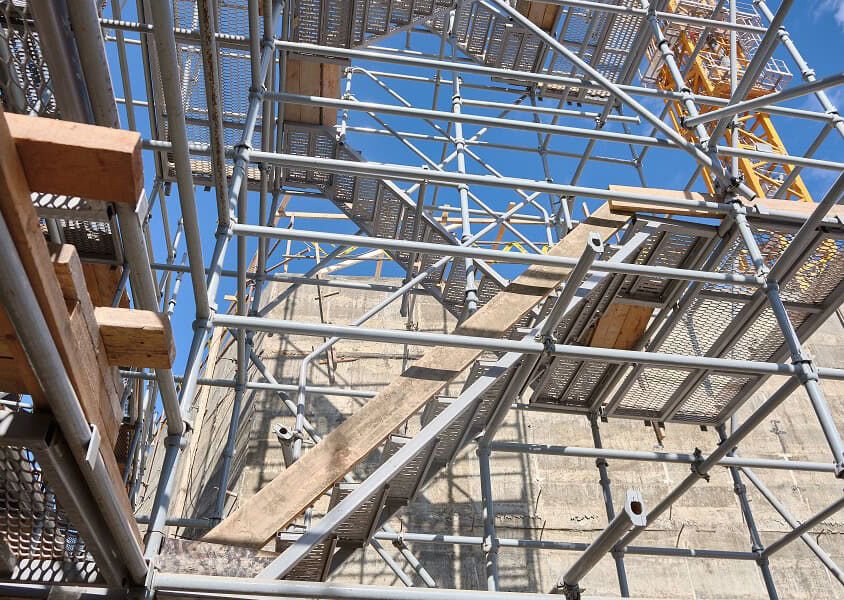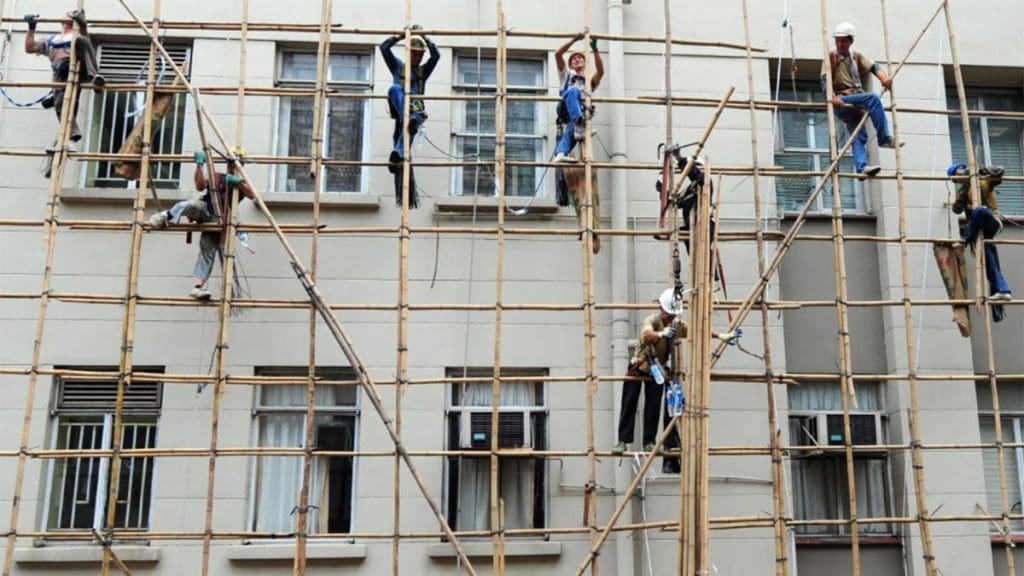Temporary Roof Scaffolding for Your Construction or Renovation Project
Temporary Roof Scaffolding for Your Construction or Renovation Project
Blog Article
A Comprehensive Guide to the Important Attributes of Scaffolding in Modern Building
The landscape of contemporary building progressively counts on efficient scaffolding systems that prioritize safety and security, efficiency, and technology. As jobs grow in intricacy, recognizing the crucial features of scaffolding ends up being essential for making sure employee safety and enhancing task timelines. This overview checks out numerous sorts of scaffolding, highlights crucial safety and security functions, and analyzes material innovations that contribute to performance and sustainability. Nevertheless, the implications of these aspects expand much past mere building techniques, prompting a better check out how they influence general job success and employee well-being.
Types of Scaffolding
Although scaffolding systems can vary extensively in layout and application, they normally fall under several distinctive classifications that satisfy different building and construction demands - Scaffolding. The most common types include sustained scaffolding, suspended scaffolding, and rolling scaffolding
Supported scaffolding is composed of systems sustained by a framework of posts, which supply a elevated and stable working surface area. This type is normally utilized for jobs that need significant altitude, such as bricklaying or external painting.
Put on hold scaffolding, on the other hand, is used for projects requiring access to high elevations, such as cleaning or repairing building facades. This system hangs from a roof or another framework, enabling workers to reduced or raise the platform as needed.
Moving scaffolding attributes wheels that enable simple movement throughout a work website. It is particularly useful for tasks that call for frequent relocation, such as indoor operate in big areas.
Each sort of scaffolding is made with details applications in mind, making certain that building and construction tasks can be performed effectively and successfully. Understanding these categories is vital for selecting the proper scaffolding system to fulfill both task needs and website problems.
Key Security Attributes
Safety is extremely important in scaffolding systems, as the prospective threats related to working at heights can cause significant crashes if not properly managed. Secret security features are necessary to guarantee the health of workers and the honesty of the building website.
Primarily, guardrails are critical. These barriers supply a physical protect against falls, significantly minimizing the threat of severe injuries. Furthermore, toe boards are typically made use of to stop tools and materials from diminishing the scaffold, protecting workers below.
One more essential element is the use of non-slip surface areas on platforms. This attribute improves grip, particularly in adverse climate problems, thus reducing the likelihood of slips and falls. Accessibility ladders ought to be securely positioned to promote risk-free access and departure from the scaffold.
Normal evaluations and upkeep of scaffolding systems are additionally crucial. These inspections make sure that all parts are in great condition and working properly, attending to any kind of wear or damages immediately.
Last but not least, appropriate training for all personnel involved in scaffolding operations is necessary to ensure that they comprehend security protocols and can identify potential threats. Scaffolding. Jointly, these features develop a more secure working setting and significantly reduce threats connected with scaffolding
Product Innovations
Developments in material science have significantly affected the scaffolding industry, enhancing both security and effectiveness in modern-day building and construction. The intro of high-strength steel and aluminum alloys has transformed conventional scaffolding systems.
In addition, ingenious composite materials, such as fiberglass-reinforced plastics, have actually become practical options. These materials are resistant to rust and environmental deterioration, hence extending the life expectancy of scaffolding systems, specifically in severe climate condition. Using such products adds to decrease upkeep expenses and makes certain consistent performance in time.


Layout Considerations
Thinking about the intricacies of modern-day construction projects, efficient scaffolding layout is paramount to making certain both performance and security. Layout considerations must include various elements, including lots ability, height, and the specific demands of the building and construction site. Each task look at this site presents special challenges, necessitating a flexible method to scaffolding systems that can adapt to varying problems.
Architectural stability is essential; consequently, designers should determine the tons that the scaffolding will certainly support, including employees, materials, and tools. The selection of products plays a vital duty in making sure the scaffolding can stand up to these lots while staying lightweight and sturdy. In addition, the style needs to allow for easy access and egress, promoting the smooth movement of products and personnel.
Security features, such as guardrails and non-slip surface areas, must be incorporated to decrease dangers of accidents. Moreover, the format should take into consideration the surrounding setting, consisting of possible dangers and adjacent structures. By resolving these style factors to consider, building and construction companies can boost the performance of scaffolding systems and advertise a more secure working setting, inevitably adding to the general success of the task.
Upkeep and Examinations
The effectiveness of scaffolding systems extends past first layout and implementation; ongoing maintenance and routine examinations are essential to guaranteeing their continued performance and safety throughout the period of a project. Normal evaluations should be performed by certified personnel to recognize any kind of signs of wear, damage, or instability that could endanger the stability of the scaffolding.
Maintenance methods ought to consist of regular checks of structural parts, such as slabs, frames, and fittings, making certain that all components stay protected and free from corrosion or various other wear and tear. Additionally, the capability of safety functions, such as guardrails and toe boards, have to be analyzed to ensure compliance with safety and security regulations.
Documentation of all evaluations and upkeep activities is essential for responsibility and governing compliance. A systematic approach to record-keeping not just help in tracking the condition of the scaffolding yet additionally offers essential evidence in case of an event.
Ultimately, establishing a detailed maintenance and examination routine will significantly lower the threat of mishaps and my site improve the overall safety of the building and construction website. By focusing on these practices, building and construction managers can secure employees and copyright the project's honesty.

Verdict
To conclude, the vital functions of scaffolding in contemporary building and construction include a series of crucial components, including diverse kinds, essential safety mechanisms, material innovations, and thoughtful style considerations. Highlighting safety and security via guardrails and non-slip surfaces, together with advancements in materials like high-strength steel, boosts both efficiency and sustainability. Moreover, regular upkeep and assessments are vital for making sure architectural honesty and security on building sites, ultimately facilitating efficient project execution and promoting the health of workers.
The landscape of modern building and construction increasingly counts on reliable scaffolding systems you can look here that prioritize performance, innovation, and safety.Improvements in material science have dramatically affected the scaffolding market, enhancing both safety and performance in contemporary building. On the whole, these product technologies not only boost the efficiency and safety and security of scaffolding systems however also straighten with the industry's press towards sustainability, as lots of modern-day products are designed to be much more ecologically pleasant.
Taking into consideration the complexities of modern building projects, effective scaffolding layout is paramount to making sure both functionality and safety.In conclusion, the important attributes of scaffolding in contemporary construction include a range of important components, including varied types, key security devices, product developments, and thoughtful design factors to consider.
Report this page